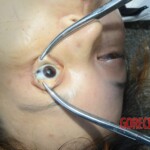BEIJING, CHINA, 2020 In a city park on the outskirts of Beijing, the dead body of a woman was found. She had multiple stab wounds, including injuries to her hands, which suggests she tried to defend herself during the attack. Forensic experts called to the scene did not find enough blood traces there, from which they concluded that she was murdered elsewhere.
Forensic analysis further revealed that the stiffness of her muscles corresponded to a time of death 8–10 hours before the discovery. On the white of her eye, there was a dark spot known as “Tache noire de la sclérotique.” This phenomenon occurs after death when the victim’s eyes remain partially open and the sclera is exposed to dry air for a long time. This condition often appears in enclosed cars, so it is not hard to assume that the body was transported to the crime scene by car.
A total of five stab wounds were found on her body in the chest and abdominal areas. Of these, only one was identified as fatal. The absence of livor mortis even so long after death indicates that she died from excessive blood loss.
In China, it is quite common to perform the initial investigation and sometimes even the forensic autopsy directly at the crime scene (place of discovery). The advantage is the quick securing of evidence and the fact that forensic experts are directly exposed to the discovery environment. However, one of the disadvantages is the risk of contamination.







































